Glossary
2-connected graph
A 2-connected (biconnected) graph is a connected graph that will remain a connected graph if a discretionary node is removed. (In other words, a graph in which at least two distinct paths exist between every two nodes.)
 |
accelerator
An immediate command triggered by a specific keyboard event. The event is recognized by the container or manager that calls a predefined function.
acyclic graph
A graph that has no cycles.
alignment
The lining up of objects on one of their edges.
API
Application Programming Interface. Software that enables external applications to access and implement code that provides otherwise inaccessible functions.
ASCII
American Standard Code for Information Interchange. A standard coding method for computer representation of alphanumeric and other characters.
application-wide session
A globally defined SQL session that can be shared by multiple SQL data source objects.
attachments
A feature establishing the relationship between 1) the size of an object and the size of the window in which it is contained, 2) a side of an object and the corresponding side of the window. The feature allows you to define whether objects change when the window in which they are contained changes, and, if so, how. See also elastic, fixed.
automatic layout
A layout process where the layout algorithm does everything without any user intervention.
base class
In C++, the class from which another class is derived.
biconnected graph
See 2-connected graph.
bitmap graphic
A graphic image made up of an array of bits or pixels in memory. See pixel.
BMP
Bitmap graphic format.
bound variables
Special markers used in SQL statements in place of literal values.
bounding box
The smallest possible rectangle surrounding one or more objects.
buffer
A part of the memory in a computer used for holding temporary data.
bus topology
A type of network topology where a set of nodes is connected to a bus object.
button
In a computer graphic interface, an object that, when clicked, initiates a predefined action.
C++
An object-oriented computer programming language based on the C programming language.
CADRG format
Compressed ARC Digitized Raster Graphics. A map format for scanned maps published by the U.S. National Imagery and Mapping Agency (NIMA)
callback
A function invoked by the operating system when a specific event, such as a mouse click, occurs.
class
A program model of a group of objects with similar characteristics.
combo box
A GUI gadget used to display items in a pop-up menu for selection. See gadget.
command log
In Views, the list of user commands applied to objects that can be used to undo or redo previous commands.
COMMIT
An SQL command that successfully terminates a transaction by permanently updating the database. See also ROLLBACK.
connected component
A connected component of graph G is a maximal connected subgraph of G.
connected graph
A graph where there is a path connecting each pair of nodes.
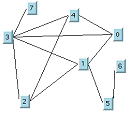 |
connection
Another name for an edge of a graph. See also edge.
constructor
In C++, a special member function called to initialize an object
container
An object in Views that contains a set of gadgets. A container is also referred to as a panel.
cut-edge
An edge is a cut-edge if the graph is no longer connected when the edge is removed from the graph. In the following illustration, the link between nodes 3 and 5 is a cut-edge. Note that its end points are cut-nodes.
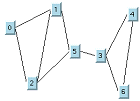 |
cut-node
A node is a cut-node if the graph is no longer connected when the node is removed from the graph. In the following illustration, node 5 is a cut-node.
 |
cycle
A path of a graph that begins and ends on the same node. Also called a loop.
cyclic graph
A graph that contains cycles.
cyclomatic number
A number equal to m - n + 1, where m = number of edges and n = number of nodes. In the following illustration, the number of edges = 10, the number of nodes = 8. Therefore, the cyclomatic number is 10 - 8 + 1 = 3
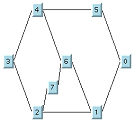 |
database
A computerized collection of data stored in such a way that it can be retrieved and displayed by application software. See also relational database.
database management
Software that manages the interaction between users and the database.
database table
The form (columns and rows) in which data is organized in a relational database (see also relational database).
data cache
A region of a computer memory used for storing data that usually resides elsewhere to make it more easily accessible.
data source
In Data Access, an object that manages the flow of data between a remote database or other source of data and an application. The data source can be connected to a database for retrieval and insertion of data and to gadgets for the display of data. It uses a data cache to store the data in tables for these purposes. See also data cache.
data-source-aware gadget
A special gadget that can be linked to a data source and used to display and edit data originating from a database.
DbField
A data-source-aware gadget that can dynamically change its look.
DBMS
See database management system.
degree
The degree of a node is the number of neighbors of the node.
destructor
In C++, a special member function called when an object is destroyed.
dimmed
In a graphical user interface, an item that is grayed out and cannot be selected.
directed graph
A graph in which every edge is associated with an ordered pair of nodes. Also called an oriented graph.
disconnected graph
A graph is disconnected if at least two nodes are not linked by a path. In the following illustration, node 5 is not linked by a path to any other node. Nodes 3 and 4 are not linked by a path to any nodes other than nodes 3 and 4.
 |
double buffering
A technique for displaying animated graphics on a screen without flicker.
drag-and-drop
In a graphical user interface, an operation whereby an object is moved by dragging it with the mouse and leaving it in another location.
DTED format
Digital Terrain Elevation Data. A map format for terrain elevations published by the U.S. National Imagery and Mapping Agency (NIMA).
DTM
Digital Terrain Model.
dump file
A file created for printing out data.
edge crossing
See link crossing.
edge
An edge connects two vertices in a graph. An edge is also called a link or a connection. In this documentation, the term link is primarily used for the term edge.
Editing Modes area
In Data Access, the area of the Main window containing buttons for changing the editing mode to selecting, text editing, menu editing, line creating, and so on.
elastic
An attribute of an attachment given to an object to allow it to proportionally change its size or its distance from the edge of the window in which it is contained as the window is resized. See attachments, fixed.
File Selector
A window used to select a file for operations such as opening, saving, importing, and so on. Also called File Chooser.
fill pattern
A design used to fill up an enclosed space in a graphic image.
fixed
An attribute of an attachment given to an object to make unchangeable the distance of one side of an object from the corresponding side of the window in which it is contained when the window is resized. Also, to make unchangeable the size of the object when the window is resized.
fixed nodes
If the user specifies a node as fixed, layout algorithms are not allowed to move this node.
fixed links
If the user specifies a link as fixed, layout algorithms are not allowed to reshape this link.
focus chain
The order in which objects in a window are selected (that is, own the keyboard focus) as the Tab key is repeatedly pressed.
force-directed layout
A class of layout algorithms for creating straight-line drawings of undirected graphs based on an iterative computation of the position of the nodes according to a set of attractive and repulsive “forces”. These forces are computed in such a way that they tend to produce a layout with only a few link crossings or no link crossings.
foreign table
A table object that is used to specify a mapping for a particular column in another table object.
form
In Data Access, a group of gadgets and other elements used to display or edit one row of a data source table at a time. See also data source.
gadget
A graphic object used as an interactive item in a graphical user interface; for example, buttons, scroll bars, sliders, and text fields.
Gadgets panel
In Views Studio, a window containing graphical user interface gadgets that can be dragged to the work space for editing.
Gantt chart
A type of chart for comparing rates, often used in production planning as a timeline bar chart.
generated code
In Views Studio, the C++ code that corresponds to the interface panel being created and which can be generated at will.
generic inspector
The area of the main window that displays the attributes of an object selected in the work space.
geometry
A map feature geometry is information relating to its shape (line, polygon, raster, and so on) and position.
global scope
A data source that can be accessed from panels other than the one it is contained in, is said to have global scope.
graph
A graph consists of a finite set of nodes (also called vertices) connected by a finite set of links (also called edges or connections).
grapher
In Views, an instance of the class IlvGrapher. More generally, an object that is used to manage a collection of nodes and links.
graph layout
The process that applies a layout algorithm to a graph. The graph drawing that results from a layout process.
graph model
In the Views Graph Layout package, a class that defines a suitable, generic API for graphs or an instance of the class (IlvGraphModel).
graphic object
A defined pictorial entity having functionality that allows it to be drawn, saved, and resized. There are many predefined graphic objects such as rectangles and ellipses as well as more complex objects such as shaded labels, zoomable icons and gadgets.
graphic primitive
A basic drawing function for creating geometric forms such as a point, line, arc, and so on.
graphical user interface (GUI)
The window and graphic objects displayed on the screen with which the user interacts to operate a computer program.
Graphics panel
In Views Studio and ilvdraw, a window containing predefined graphic objects that can be dragged into the Views Studio Main window for editing.
grid drawing
A drawing where nodes and link bends have discrete (integer) coordinates.
GUI
See graphical user interface.
guide
In Data Access, a line used as a reference for attaching objects to a window. See also attachments.
handle object
In Views, an object used to reference another object. Using handle objects, the same object can be displayed more than once without duplicating it.
header file
In C++, a file containing the interface to a class or set of related functions and data declarations. Same as include file.
hook
In Views, a mechanism whereby an event is detected in a view causing a virtual member function to be called.
icon
A graphic image used in a GUI to represent a particular object or function.
Views Studio
In Views, the editor for building a GUI.
incident
A link is incident to a node if the node is at one end of the link. A node is incident to a link if that link is incident to the node.
include file
Same as header file.
incremental layout
A layout process where the result of a previous layout is used as the starting inspector panel.
interactor
A behavior that can be attached to an object to make it function in a certain way. For example, a button interactor attached to an object makes that object act like a button. See behavior.
join
An operation whereby two tables are combined to give a new table.
key
See primary key.
layer
In Views, the storage area of a manager in which graphic objects are placed. A manager uses multiple layers, indexed by index numbers. Objects in a higher-numbered layer are displayed in front of objects in a lower-numbered layer.
layout algorithm
The process that computes new coordinates for nodes and/or new shapes for links in order to obtain a suitable representation of a graph.
layout region
In the Views Graph Layout package, the rectangle where the graph drawing will be placed when the graph is laid out.
layout listener
In Views, layout listeners allow you to connect events that occur in the graph layout algorithms to actions to be performed.
library
In data processing, a collection of reusable software components.
link
Another name for an edge in a graph. In this documentation, the term link is primarily used for edge. See also edge.
link crossing
Link crossings occur when links intersect at places other than an incident node. Also called edge crossings. Often, layout algorithms are used to minimize the number of link crossings.
listener
See layout listener.
load-on-demand
Load-on-demand is a mechanism that lets you load into memory only the portion of a map that you want to view. This capability is implemented via a specific manager layer, called a tiled layer.
locale
A collection of data and/or methods that allow internationalized C library and system-dependent library functions to comply with the users’ language, local customs, and data encoding. The locale determines the characters and fonts used to display the language. It also determines how programs display and sort dates, times, currency, and numbers.
loop
See cycle.
main function
A function which provides the entry point for an application.
makefile
In programming, a special file used to compile a program. Views Studio automatically generates a makefile to compile the panel being created.
manager
In Views, a holding place for grouping graphic objects and coordinating their behavior and display in multiple layers and views.
map feature
A map feature is an object that represents a cartographic data as it was read from its source file. It can be a segment of road, an aerial image, the summit of a hill, or a digital terrain model. A map feature holds three main information fields: its geometry, the projection in which its geometry is expressed, and its attributes.
map loader
The map loader is a facility supplied with Views Maps that allows you to import into an Views manager a map that has a predefined format. Predefined formats in Views are CADRG, DTED, Shapefile, and OGDI.
mapping
Matching tables so that cells in one table refer to specific cells in another table.
member function
In C++, an operation defined as part of a class.
memory data source
In Data Access, an entity used for holding table data in memory for temporary purposes without needing to be stored in a database. SQL cannot be used, but mapping to regular data sources is possible.
memory table
A table object in Data Access that is managed locally. It is a one-tier table.
Message area
In Data Access, an area of the Main window for displaying system messages and the class of an object selected in the work space.
Message editor
In Data Access, an editor used to create the text for multilingual messages and labels.
Message label
In Data Access, a gadget used for displaying messages.
method
See member function.
Motif
A graphical user interface built on the X Window System in the UNIX environment.
Microsoft Windows
Microsoft Windows. The graphical user interface built on MS-DOS in the PC environment.
multiline text
In Data Access, a GUI gadget used to create a text field of more than one line. See gadget.
multiple links
Multiple links occur when there is more than one link between the same origin and destination nodes.
neighbor nodes
The nodes that are connected to a given node by a link.
NIMA
National Imagery and Mapping Agency.
node
Another name for a vertex of a graph. In this documentation, the term node is primarily used for vertex.
nonplanar graph
A nonplanar graph is a graph that cannot be drawn without any links crossing other links.
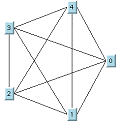 |
NP-complete
A class of computational problems for which no efficient solution algorithm has been found. Many significant computer-science problems, including many graph layout problems, belong to this class.
object interactor
A behavior that can be applied to an object.
object-oriented
A type of computer programming that focuses on the data to be manipulated (objects) rather than on the methods (procedures) that do the manipulating.
one-tier table
A table where rows are managed in the process memory space. Only the local process is implemented to manage the table.
option menu
In Data Access, a GUI gadget used to create a pop-up menu.
orthogonal drawing
A drawing where each link is drawn as a polygonal chain of alternating horizontal and vertical segments.
palette
In Views, a specific collection of resources (fill patterns, line patterns, colors, font attributes), which can be shared by any number of objects. See resource.
Palettes panel
In Data Access, a window containing graphical user interface gadgets that can be dragged to the Data Access work space for editing.
panel
A window that contains mainly gadgets.
path
The hierarchy of directories from the root directory to the directory in which the current file is found.
pixel
The smallest element in a raster graphic image. Pixels are arranged in a two-dimensional array to make up the image.
planar graph
A planar graph is a graph that can be drawn with no links crossing other links.
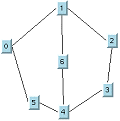 |
polyline drawing
A drawing where each link is drawn as a polygonal chain.
pop-up menu
A menu that appears when an item is clicked in a GUI.
PostScript
A page-description language for printing.
POSIX
Portable Operating System Interface.
primary key
In a relational database, the unique identifier for a table. It consists of one or more columns having the property such that each value of the row in those column(s) must be unique.
primitive
See graphic primitive.
projection
A map projection consists of projecting the surface of the Earth, or a portion of it, onto a flat surface such as a piece of paper or a computer screen. Since the Earth has an ellipsoidal shape, attempts to project its points on a plane always results in some kind of distortion of conformality, distance, direction, scale, and area. Map projections fall into three main categories: cylindrical, conic, or azimuthal. A projection can also be conformal, meaning that it preserves angles, or equal area, meaning that it displays true area ratio. A map has always an associated projection.
prompt panel
A window that appears on the screen asking the user to provide information so that the program can continue.
quadtree
A type of data structure for efficient management of large quantities of data.
radial drawing
A layout style where the nodes are placed radially around a root node.
regional buffering
A technique for more efficiently redisplaying graphics on the screen.
relational database
A database in which the user perceives the data as structured in tables (that is, in columns and rows), as opposed to, for example, a database structured as a hierarchical tree.
renderer
A renderer is an object that transforms a map feature into an Views graphic object that can be displayed via a manager.
resource
In Views, an attribute that can be applied to graphic objects. It includes color, line style, fill pattern, and font. It is a string that can be used to customize an aplication at run time. See also fill pattern.
resource file
A file that stores a set of data blocks that can be retrieved at run time using the name with which they were associated when building the file.
ROLLBACK
An SQL command that cancels a transaction. See also COMMIT.
root directory
The first level in the hierarchy of directories containing files.
S57 format
S-57 is the electronic data transfer standard prepared by the International Hydrographic Organization (IHO) committee. The geodatabase model allows the user to import Electronic Navigational Charts (ENC) .000 files, which in turn provides the user with a highly accurate vector data set that is ideal as foundation data.
scale filter
A scale filter is a filtering functionality that you can use to show or hide a manager’s layer, and hence its contents, when its scale factor is between specified values.
schema
The organizational structure of the database.
scroll bar
Horizontal and vertical sliders that permit the user to move the contents of a window to show data that cannot be displayed in one frame.
scrolled combo box
A GUI gadget used to display items in a pop-up menu with a scroll bar for selection. See gadget, scroll bar.
scrolled string list
A GUI gadget used to display a list of items with scroll bars. See gadget, scroll bar.
seed value
The value that is used for the initialization of a random numbers generator. Some layout algorithms use random numbers during the layout computation.
Selection editing mode
In Views Studio, the editing mode for selecting, moving, and resizing objects.
selector
A composite gadget made of more than one toggle button functioning so that when one button is selected others are not.
self-link
A link whose origin and destination nodes are the same node.
semi-automatic layout
A layout process where the user makes manual improvements to the result of the automatic layout process.
Shapefile format
An exchange format for vector maps of the Environmental Systems Research Institute (ESRI). This format supports polygons, arcs, lines, and points.
shell
An interface operating on top of a computer operating system to allow the user to more easily manipulate programs and data.
slider
A GUI gadget used to activate a continuous action by dragging a button with the mouse.
source file
The file containing the original code for implementing an application.
spanning tree of a graph
A spanning tree S of a graph G is a subgraph of G containing all the nodes of the graph and whose links are a subset of the links of the graph. The number of links of G that are not present in S must be the minimum number for which there are no cycles in S. The spanning tree is shown by the red links in the following illustration.
 |
SQL
See structured query language.
SQL Session
In Data Access, an object that encompasses a dialog between an application and the DBMS, that is, a connection between the application and the database.
static layout
A layout process where the layout algorithm is completely redone each time the graph is changed.
straight-line drawing
A drawing where each link is drawn as a straight line segment.
string list
In Data Access, a GUI gadget used to display a list of items.
structured query language
(SQL)
(SQL)
A computer language used with relational databases. See also relational database.
subclass
In C++, a class situated below its parent class in the class hierarchy. It inherits features from the parent class.
subgraph
G' is a subgraph of G if its node and link sets are included in the node and link sets of G.
submenu
A menu that appears when an item is selected in a higher-level menu.
system (DBMS)
Such as requests for access, retrieving and inserting data, creating database tables, and so on.
table
The form (columns and rows) in which data is organized in a relational database. See also relational database.
table buffer
A special buffer that stores a row of a table in Data Access.
table gadget
A database-specific gadget used for displaying data in table form. It can be updated through connection to a data source. See also data source, gadget.
table hook
An object that is used to monitor the current state of a table object.
table object
An instance of the IliTable class in Data Access. This object is an abstract representation of a table that is used to handle data. Data-source-aware gadgets can be linked to a column of a table object to display the column values.
text field
A GUI gadget used to display text in one line for display and editing.
TIFF
Tagged Image File Format.
tile
A tile is a rectangular area that constitutes the basic element of a tiled layer. A tile can be loaded into memory and be visible in a view or can be placed in a cache. Cached tiles are still loaded into memory but are no longer visible. Cached tiles are eligible for unloading.
tiled layer
A tiled layer is a particular type of manager layer specifically designed to support load-on-demand. A tiled layer is divided into a set of rectangular tiles of identical size that form a tiling grid.
toggle button
In Views Studio, a GUI gadget used as an off/on switch. Also called toggle switch.
toggle selector
A data-source-aware composite gadget made up of more than one toggle gadget that functions so that when one button is selected the others cannot be selected.
toolbar
A set of buttons used to trigger commands when creating and manipulating windows and applications.
transformer
In Views, an operation that changes a graphic representation by moving, scaling (zooming), or rotating.
tree graph
A tree is a connected acyclic graph (that is, a graph that does not contain any cycles).
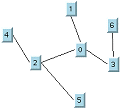 |
topology
The structure of a graph. Two drawn graphs have the same topology if you can obtain one drawing from the other by moving the nodes and reshaping the links.
two-tier table
A table that is managed on a remote database. A two-tier table interacts with another process.
undirected graph
A graph in which every link is associated with an unordered pair of nodes.
vector graphic
A graphic image made up of geometric graphic elements such as points, arcs, and lines.
vertex
A vertex is a “dot” in a graph. A graph consists of a finite set of vertices connected by a finite set of edges (also called links or connections). A vertex is also called a node. In this documentation, the term node is primarily used for the term vertex.
very graphical user interface
A computer user interface with advanced functionality. See graphical user interface.
VGUI
See very graphical user interface.
view
In Views, a view is the component where graphic objects are displayed. To display graphic objects contained in the different layers of a grapher, you create at least one view, and often multiple views. The grapher lets you connect as many views as you require to display graphic objects.
view interactor
A behavior that can be applied to a view as a whole and which thus affects all the objects in the view. See view.
widget
(Probably from "window gadget:): a reusable component of the graphical user interface which combines a predefined graphic with the program code that determines its behavior. Base of the Motif Toolkit.
work space
The area of the Main window where the GUI is constructed.
X Window
A windowing system used in the UNIX environment.
Published date: 05/24/2022
Last modified date: 02/24/2022





